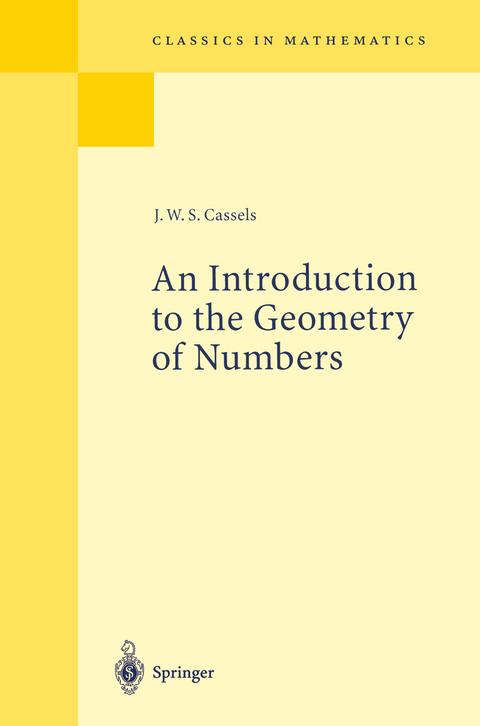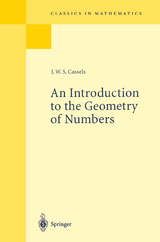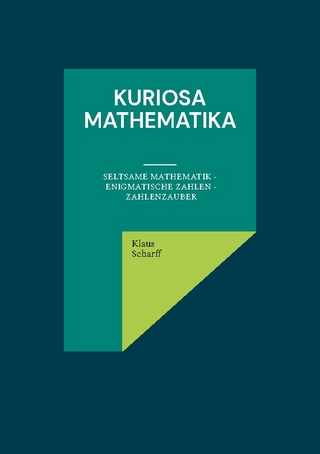An Introduction to the Geometry of Numbers
Springer Berlin (Verlag)
978-3-540-61788-4 (ISBN)
From the reviews: "The work is carefully written. It is well motivated, and interesting to read, even if it is not always easy... historical material is included... the author has written excellent account of an interesting subject." Mathematical Gazette "A well-written, very thorough account ... Among the topi are lattices, reduction, Minkowskis Theorem, distance functions, packings, and automorphs; some applications to number theory; excellent bibliographical references." The American Mathematical Monthly
Biography of J.W.S. Cassels J. W. S. Cassels (known to his friends by the Gaelic form "Ian" of his first name) was born of mixed English-Scottish parentage on 11 July 1922 in the picturesque cathedral city of Durham. With a first degree from Edinburgh, he commenced research in Cambridge in 1946 under L. J. Mordell, who had just succeeded G. H. Hardy in the Sadleirian Chair of Pure Mathematics. He obtained his doctorate and was elected a Fellow of Trinity College in 1949. After a year in Manchester, he returned to Cambridge and in 1967 became Sadleirian Professor. He was Head of the Department of Pure Mathematics and Mathematical Statistics from 1969 until he retired in 1984. Cassels has contributed to several areas of number theory and written a number of other expository books: - An introduction to diophantine approximations - Rational quadratic forms - Economics for mathematicians - Local fields - Lectures on elliptic curves - Prolegomena to a middlebrow arithmetic of curves of genus 2 (with E. V. Flynn).
Prologue.- I. Lattices.- 1. Introduction.- 2. Bases and sublattices.- 3. Lattices under linear transformation.- 4. Forms and lattices.- 5. The polar lattice.- II. Reduction.- 1. Introduction.- 2. The basic process.- 3. Definite quadratic forms.- 4. Indefinite quadratic forms.- 5. Binary cubic forms.- 6. Other forms.- III. Theorems of BLICHFELDT and MINKOWSKI.- 1. Introduction.- 2. BLICHFELDT'S and MINKOWSKI'S theorems.- 3. Generalisations to non-negative functions.- 4. Characterisation of lattices.- 5. Lattice constants.- 6. A method of MORDELL.- 7. Representation of integers by quadratic forms.- IV. Distance functions.- 1. Introduction.- 2. General distance-functions.- 3. Convex sets.- 4. Distance functions and lattices.- V. MAHLER'S compactness theorem.- 1. Introduction.- 2. Linear transformations.- 3. Convergence of lattices.- 4. Compactness for lattices.- 5. Critical lattices.- 6. Bounded star-bodies.- 7. Reducibility.- 8. Convex bodies.- 9. Spheres.- 10. Applications to diophantine approximation.- VI. The theorem of MINKOWSKI-HLAWKA.- 1. Introduction.- 2. Sublattices of prime index.- 3. The Minkowski-Hlawka theorem.- 4. SCHMIDT'S theorems.- 5. A conjecture of ROGERS W.- 6. Unbounded star-bodies.- VII. The quotient space.- 1. Introduction.- 2. General properties.- 3. The sum theorem.- VIII. Successive minima.- 1. Introduction.- 2. Spheres.- 3. General distance-functions.- 4. Convex sets.- 5. Polar convex bodies.- IX. Packings.- 1. Introduction.- 2. Sets with V(L) = 2n?(L).- 3. VORONOI'S results.- 4. Preparatory lemmas.- 5. FEJES TÓTh'S theorem.- 6. Cylinders.- 7. Packing of spheres.- 8. The product of n linear forms.- X. Automorphs.- 1. Introduction.- 2. Special forms.- 3. A method of MORDELL.- 4. Existence of automorphs.- 5. Isolation theorems.- 6.Applications of isolation.- 7. An infinity of solutions.- 8. Local methods.- XI. Inhomogeneous problems.- 1. Introduction.- 2. Convex sets.- 3. Transference theorems for convex sets.- 4. The product of n linear forms.- References.
From the reviews:
"The work is carefully written. It is well motivated, and interesting to read, even if it is not always easy... historical material is included... the author has written excellent account of an interesting subject."
-Mathematical Gazette
"A well-written, very thorough account ... Among the topi are lattices, reduction, Minkowskis Theorem, distance functions, packings, and automorphs; some applications to number theory; excellent bibliographical references." -The American Mathematical Monthly
"It is very clearly written, and assumes little in the way of prerequisites. In particular, it is accessible to an undergraduate who is willing to work a bit, and I speak from experience as I first read the book the summer before I started graduate school. At the same time, it is a serious work giving an exhaustive (and not at all watered down) account of Minkowski's theory. ... This book certainly earns its place in a series on the 'Classics in Mathematics.'" (Darren Glass, The Mathematical Association of America, January, 2011)
| Erscheint lt. Verlag | 16.12.1996 |
|---|---|
| Reihe/Serie | Classics in Mathematics |
| Zusatzinfo | VIII, 345 p. |
| Verlagsort | Berlin |
| Sprache | englisch |
| Maße | 155 x 235 mm |
| Gewicht | 552 g |
| Themenwelt | Mathematik / Informatik ► Mathematik ► Arithmetik / Zahlentheorie |
| Mathematik / Informatik ► Mathematik ► Geometrie / Topologie | |
| Mathematik / Informatik ► Mathematik ► Wahrscheinlichkeit / Kombinatorik | |
| Schlagworte | automorphs • Diophantine approximation • distance functions • geometry of numbers • lattices • minkowski's theorem • Number Theory • packings • Prime • reduction • Zahlentheorie |
| ISBN-10 | 3-540-61788-4 / 3540617884 |
| ISBN-13 | 978-3-540-61788-4 / 9783540617884 |
| Zustand | Neuware |
| Haben Sie eine Frage zum Produkt? |
aus dem Bereich




